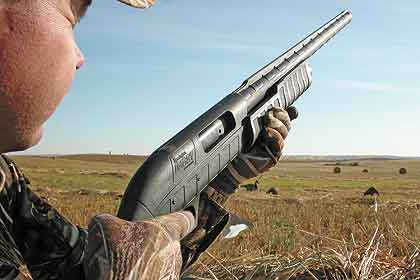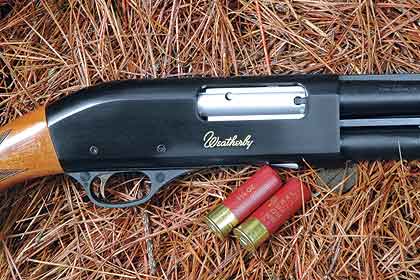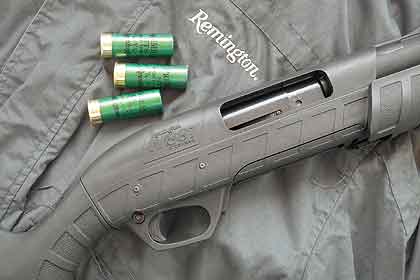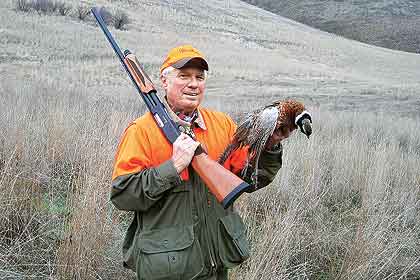The latest pump guns from
Weatherby and Remington.
By Layne Simpson
Soon after the first truly successful slide-action shotgun was introduced in the late 1800s, one firearms writer of that era looked into his crystal ball and predicted that it would have a very short life. In looking back, I am sure the fellow's opinion seemed to make a lot of sense.
 The thick synthetic coating on the steel 12-gauge barrel of the Remington Model 887 increases its diameter to about the same as that of a 10-gauge gun but it still handles quite nicely in the field. |
At the time, the semiautomatic shotgun was under development and it would become an entirely satisfactory design as soon as smokeless powder, which was also being developed at the time, replaced black powder in shotshells. Once that happened, the pump gun would quietly fade away as America's hunters quickly adopted a shotgun that automatically loaded another shell in the chamber after it was fired.
Or so it was incorrectly thought. As it turned out, the old pumper had many good things going for it and as a result it has gone on to enjoy a long and successful life, one yet to be matched by any other shotgun design.
Further proof of its success and continued popularity lies in the number of new models introduced during the past few years with the Weatherby PA-08 Upland and the Remington Model 887 Nitro Mag good examples.
In case you are wondering, PA-08 is short for pump action introduced in 2008. And while it was introduced late in that year, it did not begin to make its appearance on the shelves of Weatherby dealers until 2009.
 Available in 12 gauge only, the Weatherby PA-08 has blued metal, a European walnut stock and a chrome-plated bolt |
This, by the way, is not the first pump gun to be offered by this company. The Patrician was introduced in 1972 and a marvelous metal finish combined with a stock of fancy European walnut made it one of the all-time fanciest pump guns ever built but since it was considerably more expensive than its competition, it did not exactly set the world afire in sales.
It hung around in the Weatherby catalog for about 10 years before it was replaced by the Model 92, a gun that enjoyed an even shorter life. All of which brings me to the new PA-08.
The PA-08 actually shares a few design details with the earlier Weatherby Patrician. For starters, its locking bolt and forearm are connected by twin action bars, something not seen in old classics such as the Model 97 and Model 12 from Winchester. Breech lockup is accomplished when a hinged locking bolt at the top of the bolt engages a shoulder in the barrel extension.
This design detail allows the use of an aluminum receiver, which results in less overall weight than a gun with a receiver made of steel. Weights of individual guns will vary slightly due to variations in the densities of walnut stocks, but the PA-08 I have been shooting weighs precisely 71„4 pounds on my postal scale.
While I am on the subject of European walnut, the coloration of stocks on various PA-08s I have examined ranged from medium-dark to almost blonde with the stock of the gun featured in this report falling into the latter category. All the stocks I have seen could not be accurately described as fancy in grade but due to a bit of contrasting figure in the wood, neither should they be described as plain.
 A thick layer of synthetic material protects the metal receiver of the Model 887 from abuse and the elements. |
More important in a working gun, grain flow was quite straight in the grip area for maximum strength. An extremely hard synthetic finish protects the wood, prevents it from absorbing moisture and its application is as good as you will see on any shotgun regardless of price.
With a coverage of 20 lines per inch, the cut checkering is also nicely executed. Out back, the stock wears a black rubber recoil pad that actually does soak up some of the kick.
Also professionally applied is the black metal finish; it is shiny enough to be pleasing to inquiring eyes at the gun club but dull enough to avoid detection by an incoming flock of mallards in the field. I could live without the gold-colored trigger but it wouldn't be a Weatherby if it didn't have one. The transverse safety button is rearward of the trigger and while I'd rather it be up front, I will learn to live with it where it is.
I am not sure if the shell carrier is stainless steel or chrome-plated steel but either way it is not likely to rust. Located on the left-hand side just forward of the trigger guard, the bolt release could not be in a handier location for both left- and right-handed shooters. Average pull weight of the trigger is 61„2 pounds.
Available only in 12 gauge with a three-inch chamber, the vent-ribbed barrel of the PA-08 is available in lengths of 26 and 28 inches and comes with three interchangeable chokes in Improved Cylinder, Modified and Full.
Then we have the Model 887 Nitro Mag from Remington and to answer your first question, no, it is not replacing the Model 870. So, you might also ask, why the heck did they introduce it?
My guess is those chaps in Remington's pump gun department had decided they had sat on their laurels long enough and while it is true that more Model 870s have been sold since its introduction in 1950 than any other gun of its type (10 million to be exact), it is equally true that the time had come to give shotgunners something new to consider. I'd guess the Model 887 was flushed from the bushes by the Benelli Nova and the Stoeger P-350.
Through the years various finishes have been used to protect the metal parts of a shotgun from rusting but as far as I know the 887 is the first to be encased in a thick layer of synthetic material. The receiver and barrel are steel but during the manufacturing process they are placed in molds and injected with a molten polymer material. During cooling, the polymer fuses to the surface of the metal, resulting in ArmorLOKT protection, as Remington describes it.
 The author field-tested Weatherby's new PA-08 on ringneck pheasants. |
When I first saw the 887 I figured the layer of polymer added to the exterior of the barrel would increase its strength, the same as fiberglass fibers were used by Winchester to strengthen the barrel of the Model 59 back in the 1960s. Not true. As I was told, the coating is made quite thick in order to sufficiently cushion a blow to virtually eliminate the possibility of the wall of the barrel becoming dented in the field.
I'm sure enough force behind a ball-peen hammer could dent the barrel but dropping the gun in a boat or even in a pile of rocks is not likely to do so. And how thick is the coating? I did not measure it but I can say it is thick enough to increase the diameter of a 12-gauge barrel to about the same as a 10-gauge barrel without the coating.
When first examining the gun I figured its handling would be clumsy at best but looks were deceiving. I have not hunted with the 887 but I have shot enough clay targets with it to discover that it handles and feels much like Remington's Model 870. If anything, the 887 might be a bit livelier due to its slightly lighter weight.
The breeching system consists of a pair of rotating locking lugs at the front of the bolt that engage shoulders inside the barrel extension. Spent shells are ejected by a spring-loaded plunger. The right and left shell latches are made of heat-treated steel. The magazine tube is threaded into the front of the receiver.
The 28-inch barrel is made of Type 4140 steel, has a nominal bore diameter of 0.727-inch and accepts the Rem-Choke interchangeable choke system. Its polymer ventilated rib is integral with the synthetic outer shell of the barrel and has a red fiber-optic front sight.
The fire control assembly, or trigger plate assembly as Remington calls it, consists of various steel parts such as the hammer and sear located in a polymer housing. The entire unit is easily removed for cleaning by pushing out its two retention pins in the side of the receiver. Forearm and stock are synthetic and the latter wears Remington's extremely efficient SuperCell recoil pad.
For now, the Model 887 is available only in 12 gauge and with two finish options, black or Realtree Max-4 HD camo. Advertised weight is 71„4 pounds.
So there you have them, the latest in shotguns, the Weatherby PA-08 for those who prefer a shotgun made the way they all used to be made and the Remington Model 887 for those who prefer a shotgun made the way they all may someday be made.






